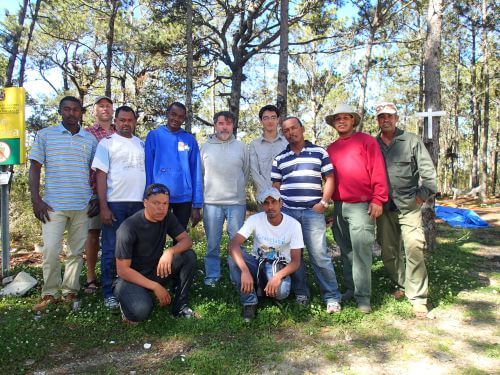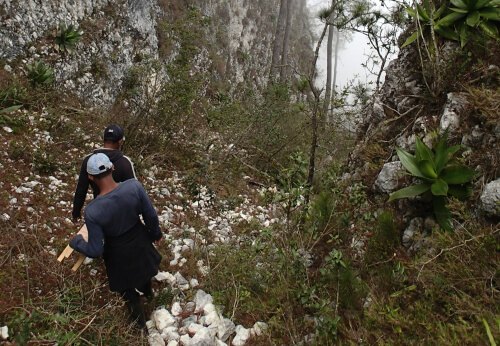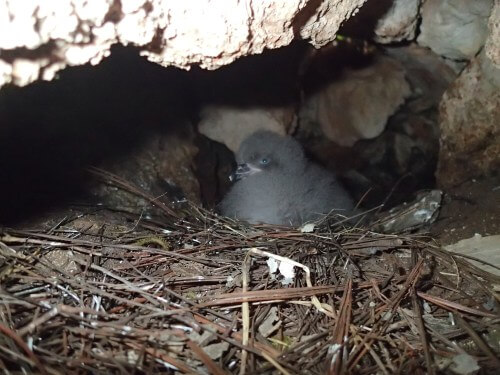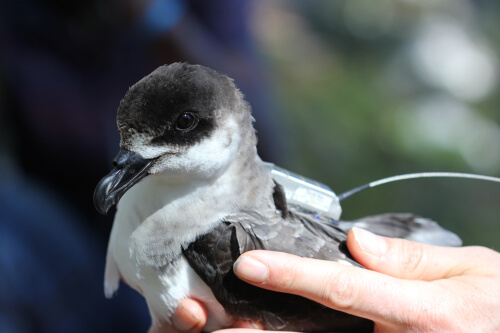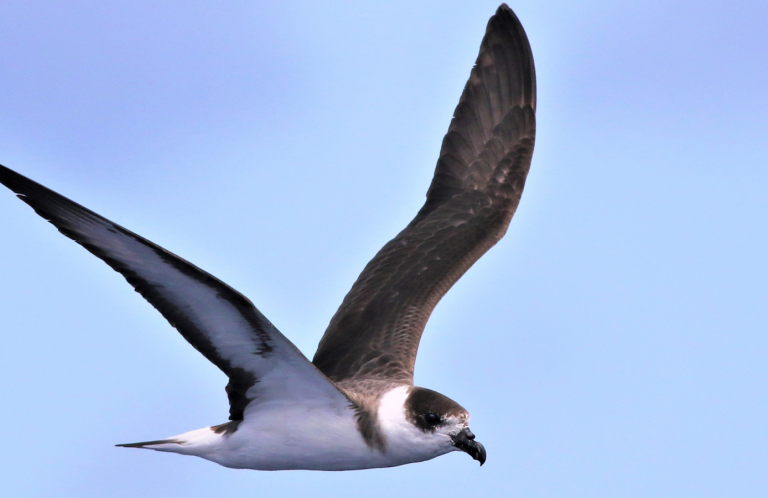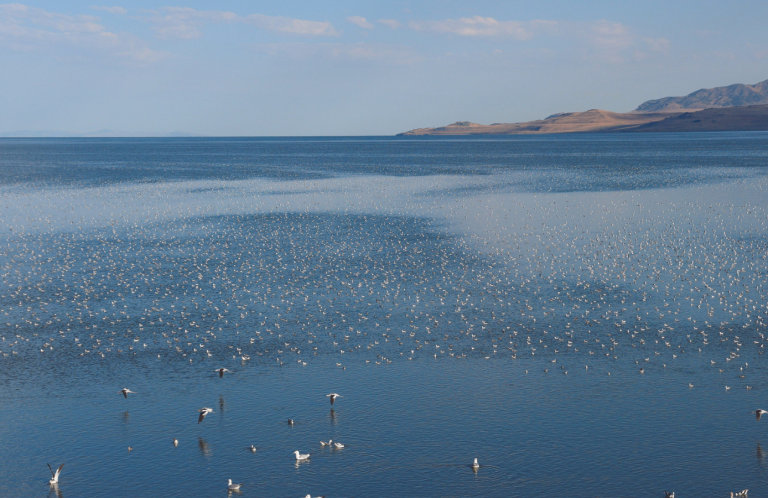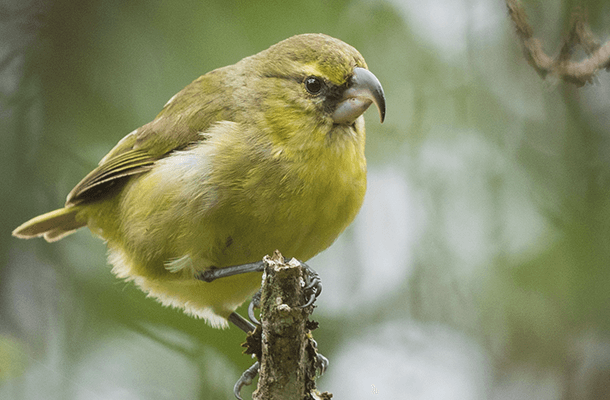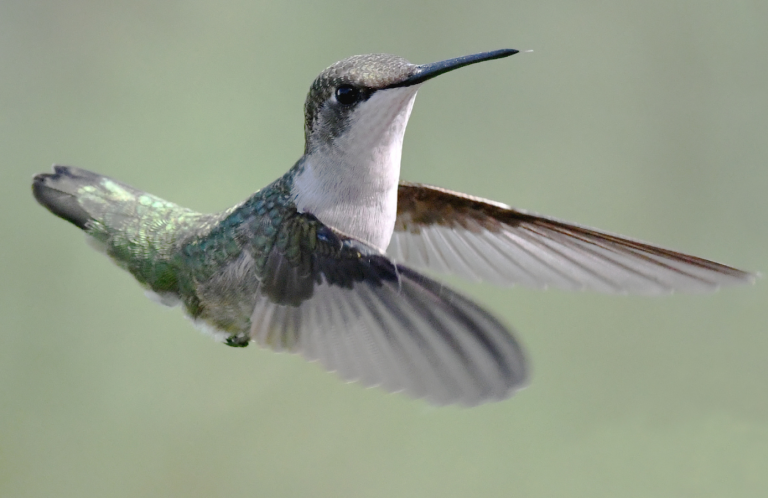Behind the Scenes: First-ever Black-capped Petrel Satellite Tracking
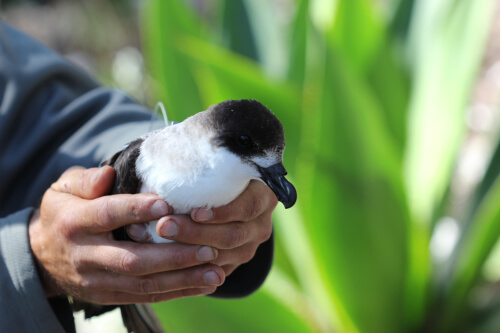
One of three Black-capped Petrels destined to carry a satellite tag for the first time in history. Photo by Tazio Taveres
By Rob Ronconi
Locally known as diablotín, which translates loosely to “little devil,” the Black-capped Petrel (Pterodroma hasitata) is one of the world's most imperiled and least known seabirds. This species was thought to be extinct for most of the 20th century, then was rediscovered in 1963 nesting high up in the mountains of southeastern Haiti.
Since then, various expeditions have found diablotíns nesting among the cliffs, boulders, and pine forests of four sites on the island of Hispaniola.
In early April 2014, in a joint project led by the U.S. Geological Survey (USGS) South Carolina Cooperative Fish and Wildlife Research Unit at Clemson University, Grupo Jaragua in the Dominican Republic, and American Bird Conservancy, I had the privilege and pleasure to join an expedition to Sierra de Bahoruco National Park in the Dominican Republic.
Our purpose: to deploy the first satellite tags on diablotín.
So How Do You Find a Diablotín?
Consider this. In Sierra de Bahoruco, expeditions have been searching for nests off and on since 1979 until the first active nest was finally found in 2002. Scrambling, crawling, and climbing, during the past four years Grupo Jaragua has discovered 45 nests in this area confined to the top 100 meters of the Loma del Toro ridge at 2,200 meters above sea level.
Cool nights and warm days merge pine forest with agave plants in a fire-prone ecosystem. Here diablotín hide their nests among sharp limestone boulders and densely vegetated north-facing slopes, so well hidden that you could be staring right at a burrow without even knowing it.
My journey began in Santo Domingo where I was met by Chapa, Grupo Jaragua's logistics man; Ernst Rupp, research and expedition leader; and Tadzio, an overseas recruit who has been volunteering at the Natural History Museum.
From here, Loma del Toro was two days' travel via Oviedo and Pedernales, where we picked up food, supplies, equipment, and, most importantly, the remaining members of Team Diablotín: Esteban, Gerson, Pirrin, Jose Luis, and René.
Climbing from sea-level to the heights of Sierra de Bahoruco, we passed through an impressive diversity of ecosystems from dry desert and coastal lagoons to humid broadleaf and towering pine forests, each carrying their own mix of endemic and migratory birds.
Sadly, though, we also passed farmlands encroaching into park boundaries. From the top of Loma del Toro, views of Haiti below were a stark reminder of the real pressure facing habitats and species on Hispaniola. Agricultural development, charcoal making, forest fires, and timber harvest are all real threats impacting the forests of Hispaniola right up to the tops of these seemingly remote mountain ranges.
Despite these threats, the pine forests atop of Sierra de Bahoruco are fairly well preserved, providing nesting sites for the cryptic diablotín and dozens of other endemic species.
The Small, Downy Reward
The long journey was rewarded with my first glimpse of a Black-capped Petrel chick sitting in the back of its burrow. The chick was still small and downy; at this time of year most eggs have recently hatched, and chicks wait in their burrows for parents to return with a big feed.
On our first evening, with the sun setting, we quickly scrambled to set “traps” (one-way doors) on burrow entrances to catch adults that would return under the cover of night. Our intent: to affix small, solar-powered transmitters on three birds that would enable us to track their movements during foraging trips at sea over the next several months.
Silent and chilled, we waited in the dark near burrow entrances for four hours, only to be duped before we called it a night.
With more time the next day we regrouped, visited more nest sites, and reconfigured our traps, this time designed to catch birds while we slept at night. Early risers found success on the second morning, when we caught our first two diablotíns destined to carry satellite tags.
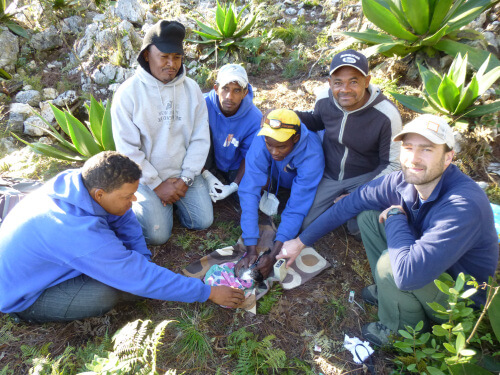
Team Diablotín prepares a petrel to carry the satellite transmitter. (Author Rob Ronconi pictured at right.) Photo by Ernst Rupp
Having studied shearwaters, storm-petrels, and gulls in the past, Pterodroma petrels were a real treat for me to work with. What diablotín lack in size in comparison with their shearwater cousins, they make up for with beautiful black and white plumage and an impressive stout, sharply hooked bill. (Our first candidate left a nice gash in my knuckle that bled through most of the tagging procedure).
Until now, Grupo Jaragua's work with the petrels had been very “hands-off,” using infra-red trail cameras and acoustic recording devices to monitor activities around burrows. So not only were we deploying the first satellite transmitters on this species, but we were even making the first-ever measurements of Black-capped Petrels during the breeding season. Each weighing in at around 400 grams (just shy of one pound), three diablotíns were equipped with transmitters.
In many ways this work marks an exciting new era in the discovery of Black-capped Petrel life histories. It was my privilege to be a part of this expedition, and we owe its success to the hard work of Grupo Jaragua!
Now we wait for these elusive seabirds to show us their secret lives at sea.
(Editor's note: You can see where the tagged Black-capped Petrels are today by visiting this website: http://www.atlanticseabirds.org/bcpe-new.)
Rob Ronconi is a seabird biologist who has studied shearwaters, petrels, gulls, terns and auks in the North Pacific, and the South and North Atlantic Oceans. Currently he is a research associate at Acadia University leading a study on bird interactions with offshore oil and gas platforms. Ronconi lives in Halifax, Nova Scotia.





































